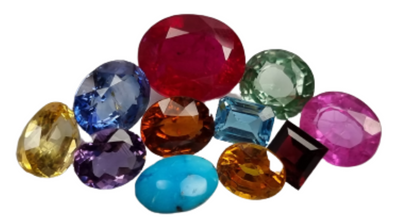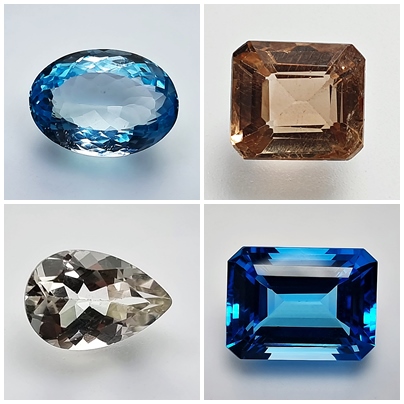About Topaz: Gemstone Information
‘Topaz’ was used as a name for aluminium fluosilicate in a description of the deposits and products of the Schneckenstein area of Saxony, Germany, by Henckel in 1737 (some crystals are still found here and some gemstones have been fashioned from them). Chemical composition: An early survey by Becke can be found in Doelter’s Handbunch der Mineralchemie, in which a yellow topaz from the Thomas Range, Utah, USA, has a density of 3.565, a fluorine content of 20.37 and a hydroxyl content of 0.19, and a specimen from Brazil with a density of 3.532 has a fluorine content of 15.48 and a hydroxyl content of 2.45. Becke also describes the effect on the refractive index of this variation in composition, the Thomas Range specimen giving an RI of 1.6072, 1.6104 and 1.6176 for the alpha, beta and gamma rays respectively, with a birefringence of 0.0104, compared with the Brazilian (Minas Gerais) specimen’s 1.6294, 1.6308 and 1.6375, DR 0.0081.
Summary: About Topaz has the composition Al2(F, OH)2SiO4 with some of the hydroxyl substituting, though not completely, for the fluorine, the physical and optical properties varying with the proportions of F and OH.
The crystallization of topaz is described in Hintze’s Hand bunch der Mineralogie, 2 Ed., pp. 102–127, 1897. This work, the all-important survey of mineral species and the different forms shown by specimens of differing composition and location, shows many forms taken by crystals of topaz. Hoover (1992) discusses this, citing several authorities but concludes that more work is needed. This area should not affect the gemmologist, prospector or mineral collector for whom topaz crystals are easy to identify.
Crystals with a lozenge (or diamond-shaped) cross section show prism faces which are often striated parallel to their length and with varying terminations. Brazilian crystals show low-angled pyramidal terminations with crystals from Utah showing a steeper angle. Some crystals from Africa (perhaps Nigeria) show a chisel-like termination due to enlargement of dome faces at the expense of the pyramids. In other crystals the pinacoid gives a flat-topped effect. Crystals cleave parallel to the basal pinacoid which is often present. Doubly terminated crystals are mentioned above.
A square cross-section is due to a dominating second-order prism. Topaz occurs most commonly in such igneous rocks as granites, granite pegmatites and rhyolites, occupying veins or cavities. Resulting most often from late-stage pneumatolytic action, topaz is commonly found in greisen. Associated minerals may include quartz, fluorite, tourmaline and beryl.
Crystals may reach large sizes though some are found in gravels, their size much diminished. The hardness is 8 and the specific gravity in the range 3.49–3.57; most gem topaz is about 3.53. The cleavage has already been noted but wearers of topaz jewelry should remember that this cleavage is very easy to start and that the resulting pearly luster of the cleavage faces is little compensation for the accident. The familiar color of most topaz, ranging from colorless through to dark orange and pale yellow, results from the activity of color centers (Nassau, 2000). Some natural brown topaz may fade on exposure to strong light (some specimens from Utah may show this). Colorless topaz crystals when fashioned make attractive and often large gemstones though their dispersion is less than that of diamond. Pink topaz contains chromium as a foreign element.
Blue topaz in Nature is attractive but generally pale; the dark blue stones now familiar in jewelry have been artificially irradiated. Colorless material when irradiated gives unstable yellow or brown color centers/stable brown or blue color centers. These cannot be distinguished from natural topaz by Gemmological testing. Nassau (2000) tells us that most colorless topaz when irradiated will turn to a combination of brown and blue – the brown color predominates.
When heated the brown disappears, leaving the blue which is unlike any natural blue so far reported. Sources of topaz are not rare though the finest examples are usually Brazilian. Looking first at pink topaz, quite exceptional crystals are found in Pakistan, where examples of yellow to sherry-colored topaz are found in the Shingus pegmatite and in similar conditions at Bulechi in Gilgit district. Other topaz-bearing pegmatites occur at Niyit Bruk and Gone, near Dusso in Skardu district (Kazmi and O’Donoghue, Gemstones of Pakistan, 1990).
However, Pakistan provides a uniquely colored topaz not occurring in a pegmatite. This is the hydrothermal vein-hosted ‘pink’ topaz which so far has been found only in Mardan district of northern Pakistan. A hillock called Ghundao is surrounded by a village of the same name. The site is about 4 km north of the small town of Katlang, whose name has become associated with the exceptional topaz found in stockworks of quartz and calcite veins. Hydrothermal orpneumatolytic origin is suggested by the absence of fluorite.
Tectonic movements may have fractured the crystals which were then incorporated into later-formed vein calcite. The gem-bearing rocks at Ghundao hill, visited and examined by the author (MO’D) in the late 1980s, consist of the following lithologic units: light grey thick-bedded largely autoclastic limestone; dark grey mediumbedded, medium- to fine-grained crystalline limestone with the lower part largely algal; thin-bedded limestone and calc shale. Further discussion of the lithology can be found in Kazmi and O’Donoghue (1990).
The topaz mineralization in this deposit is also described by the same two authors. The mineralization is structurally controlled and forms characteristic saddle-reef structures. The whole sequence has undergone north–south compression leading to tight folding, intense fracturing and faulting. In a number of places the limestone has been invaded by stock works of calcite and quartz which contain fine, perfectly euhedral crystals of quartz and topaz. The calcite veins have been largely emplaced along a series of parallel normal and reverse faults along the crests of tightly folded anticlines. The topaz-containing calcite veins show a pinch-and swell structure though some are only a few centimeters wide.
Others are larger and extensive. Topaz is not confined to these veins but is found in calcite which forms small lenticular tension gashes in limestone at the crests of folds. The mineralized fault zones commonly contain limonite or a thick coating of clay. They contain vugs and cavities which often contain euhedral topaz crystals with quartz and calcite. The color of the finest topaz crystals is unlike any pink topaz yet reported, being closer to an orange-red rather than the sometimes pale pink shown by Brazilian material. In a table listing chemical composition (Kazmi and O’Donoghue) it can be seen that the coloring agents are chromium and manganese though in some samples is absent.
Topaz from Brazil, the chief source, is described in many publications; pink topaz from Brazil is often heated to deepen the color. The publication Topaz, forming ExtraLapis no. 13 (1997; ISBN 3921656427), describes and illustrates topaz crystals from Our Preto in Minas Gerais, as well as specimens from Schneckenstein, Saxony, Germany. To take one Brazilian occurrence described by Bancroft in Gem and Crystal Treasures (1984, no ISBN) the topaz mines to the west of Our Preto contain the Don Bosco, Rodrigo Silva and Saramenha occurrences providing fine topaz [featuring in the museum at Our Preto]. Our Preto topaz is orange to pinkish purple. Fine golden topaz is also found in the Our Preto area, the names Lavro do Moraes and Antonio Pereira being familiar to connoisseurs of topaz. This topaz does not occur in pegmatite but is found in kaolinite clays penetrated by quartz and also in sedimentary iron formations consisting mainly of hematite and silica.
The Antonio Pereira mine has produced rich sherry-colored topaz. An official government account of the production of Brazilian precious stones is given extensively, from the economic standpoint but with considerable detail in what must be the all-time most important description of the gem minerals of a single major producing country. There are nearly 500 pages with mine and area plans and maps – everything the prospector could want. This is not an easy book to find; the publishers are the Departament Nacional da Product Mineral, a dependent department of the Ministerio da Infra-Estrutura. The Murzinka area of Russia is another of the classic topaz producers. It forms part of a region which is a watershed of the Neva river of the western Urals.
It includes the Alabashka field of granite pegmatites which lies in the northern part of the Murzinka sub-zone of the Ural Gemstone Belt and the Murzinka pegmatite field which is in the south of the area, in the Neva river valley. This study includes an account of the morphology and structure of the topaz-beryl granite pegmatites of the Alabashka field. Topaz is a major mineral of the Mokrusha area and appears to form four main types of crystal which the survey illustrates. Colors include blue and pink as well as near colorless but apparently not the characteristic orange-yellow brown colors.
While on the gemstone deposits of Russia it might be useful to mention the now very rare survey by A.E. Fersman, published in two parts, in 1922 and 1925. Only 1000 copies were printed of the 1925 edition of this title, Dragotsennye I tsvetnye kamni SSR [Sinkankas #2042]. Maps show and the text describes Russian gem deposits in a way that has not been repeated since, though the Mineralogical Almanac series is beginning to improve this situation.
Though the effect is not vital in everyday gem testing it is interesting to note that in general in the higher SG range, SG figures appear to indicate a higher F content. In such specimens the RI may be lower in the range and the reverse seems to be the case with (OH). Pleochroism in topaz is not strong, though more perceptible in the heated pink stones. Specimens from Pakistan show yellow, purple and deep mauve to violet. Sherry-colored topaz shows brownish yellow, straw yellow and orange-yellow. Blue specimens show colorless, pale pink and blue. Through the Chelsea color filter, the blue stones may show a greenish blue, much less pronounced than the strong blue shown by some aquamarine.





